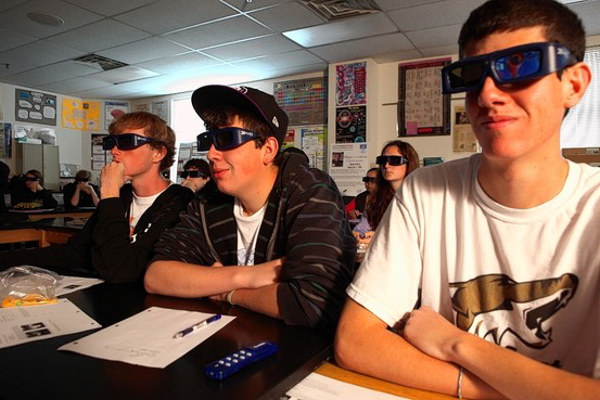[From The Wall Street Journal; a related article is available in THE Journal]
[Image: Students at Monarch High School in Louisville, Colo., watch lessons in 3-D.]
Coming Soon To Schools: Dissecting Frogs in 3-D
By Michelle Kung
September 7, 2011
When Maurio Medley, an eighth-grade math teacher at Ocoee Middle School in central Florida, wants to teach his students how to find the volume of a cylinder, he doesn’t turn to a textbook or chalkboard. Instead, he turns on a 3-D-enabled projector to rotate a virtual Euclidian solid.
Schools are trying to keep up with the multiplex, keen to find ways to engage students in an age of 3-D movies and gadgets that make traditional classroom materials look dated. And the technology and equipment makers are eager to create a new market for their 3-D products.
Mr. Medley, 30 years old, compares the experience to going on a “3-D field trip” without students leaving the classroom. “By putting on 3-D glasses, we can show them how math works in real life,” he says.
Ocoee Middle School student Madeleine Magrino, age 13, says the 3-D lessons in her sixth-grade science class last year helped her understand what cartilage in skeletal systems looked like. “You don’t want to turn away because you don’t want to miss anything,” she says.
As students head back to school this fall, more of them will find lesson plans that use 3-D, or stereoscopic, materials. Dozens of schools have invested in, or been selected to participate in, 3-D pilot programs in subjects from anatomy to astronomy.
Roughly 185,000 3-D-ready projectors will be sold to U.S. schools for grades kindergarten through 12 this year, estimates Pacific Media Associates, a market-research company. The figure is more than double the number sold last year.
Three-D entertainment, along with the growth of the iPad and mobile devices, may have primed younger generations to respond to more social and interactive teaching techniques in the classroom.
But schools have lagged behind other public sectors regarding 3-D technology, says Darri Stephens, a former teacher and independent educational consultant who has been paid to advise Discovery Education and Imax Corp., among other clients. “From the educator’s standpoint, no one wants to make our kids guinea pigs with new technologies,” she says.
Stereoscopy in schools differs from 3-D at the multiplex or on a game console. “Anyone can watch 3-D, but you need to interact with it to really learn,” says James Mayrose, an associate professor at Buffalo State College and chief executive of Tactus Technologies Inc., a software company that sells a 3-D dissectible-frog program.
Proponents of 3-D education argue that it helps students grasp concepts that are difficult to visualize. The format also engages spatial reasoning skills, leading to higher retention rates and test scores, according to pilot programs performed with donated equipment from Digital Light Processing, Texas Instruments‘ projection-technology unit, and its business partners.
In one of the industry-funded studies, the Rock Island-Milan school district in Illinois exposed two groups of sixth-grade students to a ninth-grade-level earth-science lesson. One used 2-D projection, while the other used 3-D. The students were tested before and after the lesson. Test scores for the 2-D group increased 9.7%, on average, while the scores of the students who saw the lesson in 3-D increased an average of 35%.
Financial concerns can be an obstacle for some schools. Cyber-Science 3D, an educational software line, costs $10,000 for a package that includes software, a computer, a projector and about 30 pairs of 3-D glasses. The company’s 3-D materials include a periodic table, dissectible fetal pigs and a deconstructable V-8 engine. A single, “stereo” copy of the software retails for $1,500. A single pair of active glasses from pilot participant XpanD, which differs from passive 3-D movie glasses, can cost $129.
Roughly 650 elementary schools and 100 colleges have purchased the company’s products, says Rich Lineback, president of Cyber-Science 3D parent Cyber-Anatomy Corp.
Unlike televisions that come equipped with 3-D capabilities, 3-D-ready projectors tend to cost the same as regular projectors, about $600 to $800.
Martin Banks, an optometry professor at the University of California Berkeley who has researched the health effects of 3-D, says as long as the videos are kept to increments of five to 10 minutes, there are no health problems for children.
Some schools are waiting for more 3-D materials that are in compliance with testing and graduation standards.
Officials at Columbus State Community College in Ohio, one of the 3-D pilot schools, initially had concerns about future 3-D education standards and whether the technology would bring an unwanted “camp” value to its campus, says Jason LaMar, the college’s multimedia video Web developer. But they were ultimately won over by the technology.
Content providers tend to be independent companies that submit their work-in-progress designs to academics and others who review the products for accuracy.
Few if any of the leading academic publishers, including Pearson PLC and McGraw-Hill Cos., have created their own stereoscopic course material, but Texas Instruments’ DLP says it is currently in discussions with various publishers.
